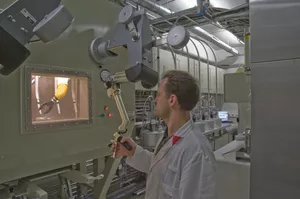Rabbit Irradiation System

The rabbit irradiation system of the FRM II is equipped with six individual irradiation channels which penetrate to varying depths in the moderator tank. The positions are vertically staggered in the moderator tank, allowing for the selection of a thermal neutron flux density. The thermal neutron flux densities range from 5·1012 to 7·1013 cm-2s-1 (see table), depending on the application.
Sample sizes should be less than 10 cm³. They are packed in polyethylene capsules (so-called rabbits) and conveyed pneumatically by CO2 into the irradiation position. The transfer only takes a few seconds; the actual irradiation time is from 30 seconds up to 5 hours, depending on the sample.
The dose rate of each irradiated sample is measured immediately after irradiation in a shielded decay position to ensure that it can be safely handled by the staff. On completion of the prescribed decay time, the pneumatic tube system brings the sample back to the starting point where its dose rate is measured again, so that the shipping documents necessary for delivery to the client can be filled in correctly. One of the most frequent users is Radiochemistry Munich RCM, also a corporate research center of the TUM. RCM is directly connected via a conveyor tube network to the rabbit irradiation system. To avoid possible cross-contamination, the gas spaces in the irradiation and conveyor tubes are separated from each other.
Applications
One typical application is neutron activation analysis (NAA), which analyzes precisely the composition of an element in a sample. For the most part, NAA provides measurements of greater accuracy than classical chemical methods. For example, for some elements NAA can detect one atom in a trillion.
For this, the sample is irradiated in a high neutron flux in the moderator tank itself. There, some atoms become radioactive by capturing a neutron. They subsequently emit gamma radiation. Each atom has a different characteristic pattern of gamma irradiation. In addition, the intensity of the gamma irradiation indicates the concentration of the particular chemical element in the sample.